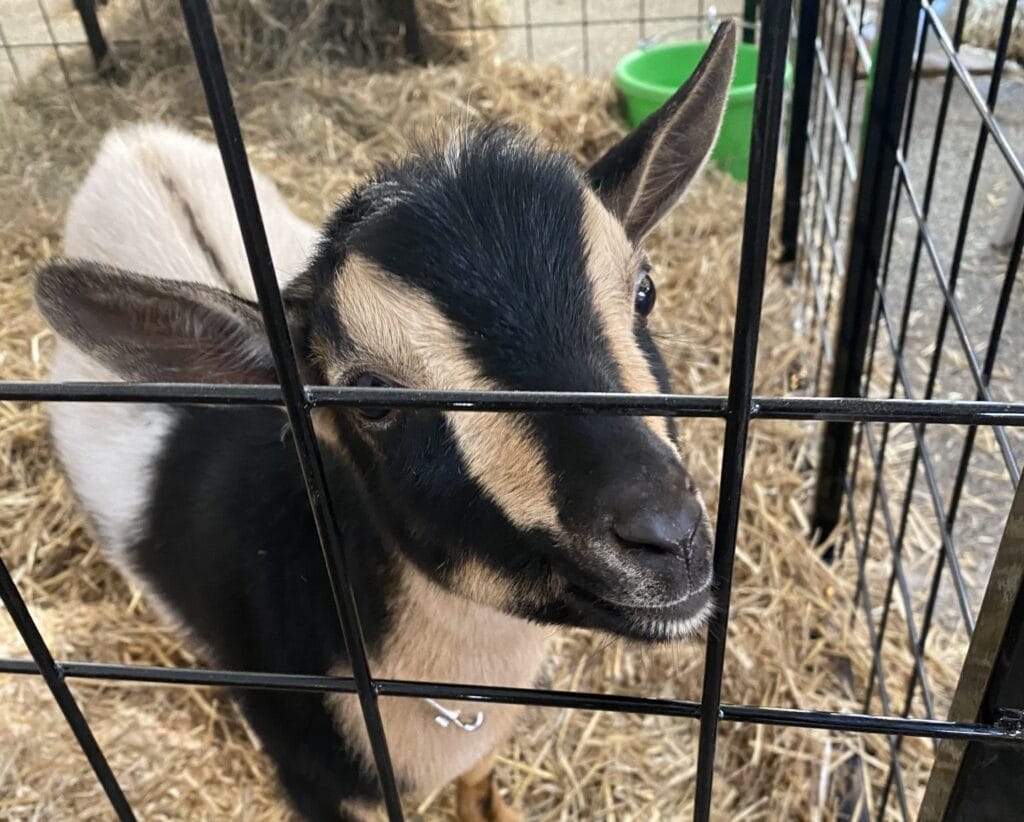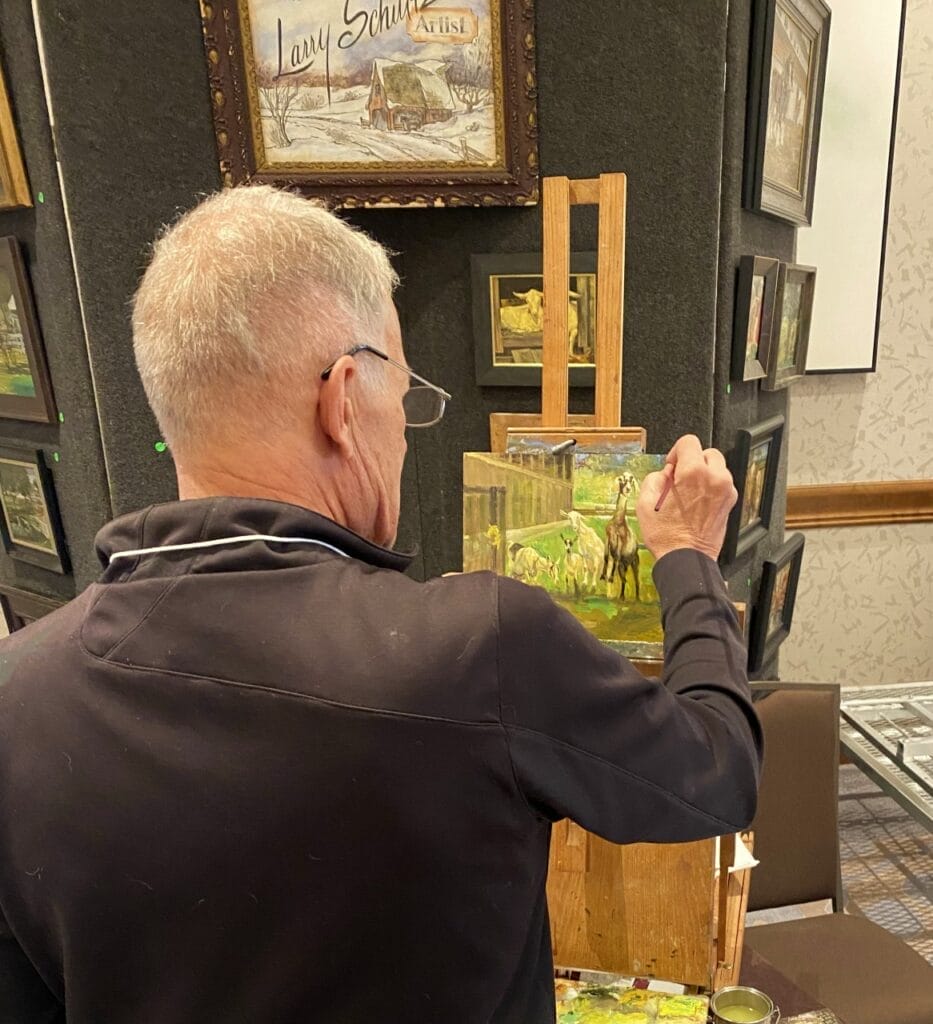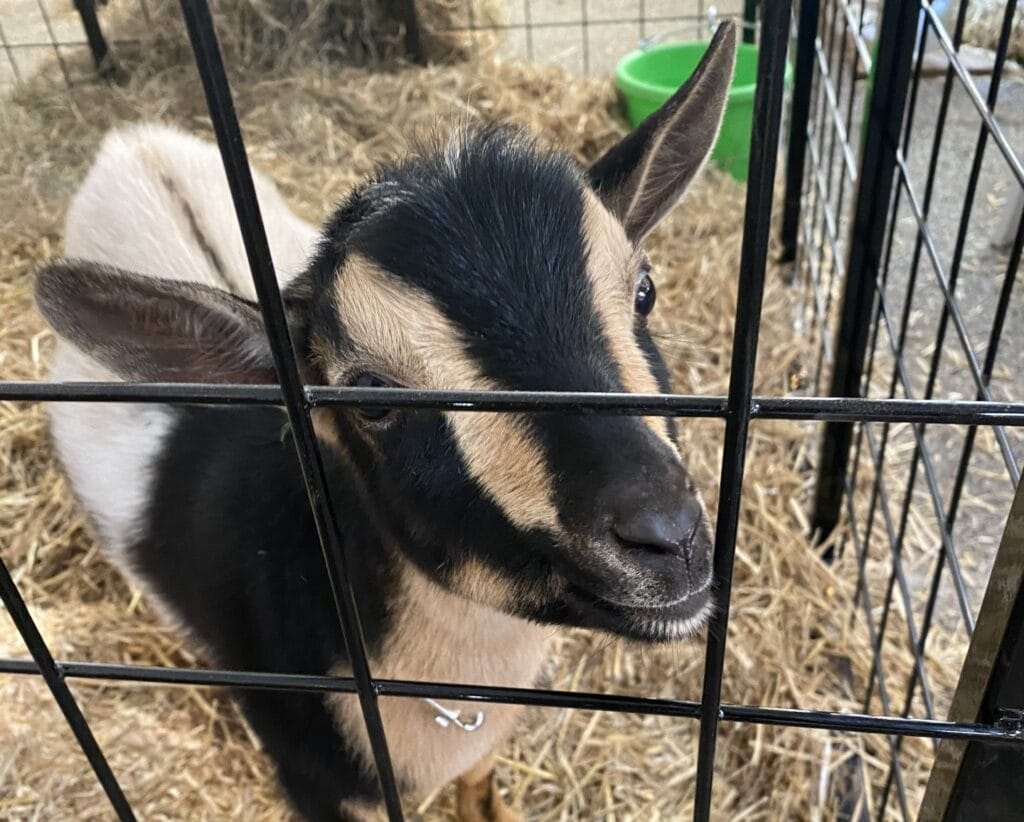This post originally appeared at https://www.badgerinstitute.org/wisconsin-the-goat-of-dairy-goats/
Cheeseheads have a new bleating heart

When it comes to dairy cow production, Wisconsin was long, well, the GOAT. For decades, the state had both the largest number of dairy cow farms and the highest dairy cow production in the country.
Wisconsin long ago lost its dairy cow preeminence, but America’s Dairyland is once again living up to its billing as Greatest Of All Time — this time in a literal way.
We lead the nation, by far, in dairy goats.
The number of milk goats in Wisconsin as of Jan. 1, 2024, was 74,000, according to the latest sheep and goats report from the U.S. Department of Agriculture’s National Agricultural Statistics Service (NASS). California, which surpassed Wisconsin cow milk production in the 1990s, has the second-highest inventory of milk goats but only half as many as the Badger State.
Cows still dominate here. There are still more than 5,300 dairy cow herds. In comparison, there were 994 dairy goat farms in Wisconsin in 2012, with an inventory of 44,000 goats, according to Greg Bussler, state statistician with NASS. In the 2022 census, there were 920 dairy goat farms — 74 fewer than 10 years prior — but with a significantly increased inventory of more than 78,000 goats.
The emergence of Wisconsin as a dairy goat powerhouse is enough to make any cheesehead proud.
“Wisconsin is number one because most goat milk is made into cheese,” says Randy Adamson, president of the Wisconsin Dairy Goat Association (WDGA). “Very little is sold as fluid milk. Goat cheese is far more popular today than it was when we started 15 years ago.”
This trend is confirmed by one of Wisconsin’s most iconic cheese outlets.
“We’ve seen a huge, huge increase in people wanting goat cheese,” says Jackson Humulock, a cheese associate at the Mars Cheese Castle in Kenosha. “I’ve been here three years, and when I started, we almost never sold goat cheese.” Since then, he says, demand has increased exponentially.
LaClare Creamery in Malone produces roughly 20,000 pounds of goat cheese a day — 6 million pounds annually — in its plant. Larry and Clara Hedrich, who founded LaClare, started with eight people working their dairy goat farm. They now employ 80 in the dairy farm, creamery, greenhouse, cafe and retail shop.
“I see the trend as growing,” says Clara, who taught high school agriculture classes for 39 years until joining the dairy goat business full time. “People are looking for healthy choices, so the goat products fit that bill very nicely.”
Wanting to instill a solid work ethic in their children, Larry and Clara purchased a small farm near Chilton in 1978, which included two goats. It wasn’t long before their family was hooked.
“When we took a vacation, we’d be traveling somewhere but we always ended up visiting goat farms or somebody making goat cheese,” says Larry.
Four of their five adult children now work with them, managing the kid farm, operating the cheese factory, running the meat market, the retail store, the cafe and the website.
In 2005, the Hedrichs were instrumental in forming the Quality Dairy Goat Producers Cooperative of Wisconsin. The co-op initially consisted of six farms. There are now more than 110 farms participating.
“We have the infrastructure here to do dairy, so it’s a natural transition and explains why Wisconsin would be a leader in dairy goat production,” said Bussler. “Cheese production is the main driver of both dairy goat and cow production. That’s what keeps us strong.”

The global goat cheese market was valued at $6 billion in 2022 and is projected to reach more than $9 billion by 2032, according to the Goat Cheese Market Report published by Allied Market Research in February 2024.
Goat milk is also used in ice cream, yogurt, butter, skin lotion and soap, among other things.
While the popularity of these products is driving the growth of dairy goat farms across the country, Wisconsin has other advantages that contribute to its dominance, says Jamie Perry, a dairy nutritionist with Furst-McNess, a producer of animal health products.
“[Wisconsin has] already been a leading contender in the dairy cattle industry, so we have the infrastructure here,” says Perry, who runs a hobby farm of 45 goats with her husband in Stratford. “We know how to transport the milk, get it processed. We have all of the feed suppliers, and our environment is very conducive to growing high quality feeds, so we can limit how much feed we have to buy.”
In her role as a nutritionist, Perry has worked with both dairy cows and dairy goats over the past 18 years, and she’s seen producers transition from cows to goats. Several factors lead farmers to make the switch, she says, including the fact that the size of goats makes them more manageable and frees up space.
“Goats are easier to work with,” says Adamson, noting that goats tend to weigh around 150 pounds while cows weigh closer to 1,500 pounds.
“From a commercial standpoint, start-up costs are so much lower (with goats),” he says. “You don’t need the same size buildings for 200 goats as you do for 200 cows. Building costs and equipment costs are lower. There is access to used milking equipment from cow dairies that have sold their cows.”
Adamson grew up milking cows on his family’s dairy farm and as an adult had his own farm with 60 milk cows from 1979 to 1983. But the 1980s were a difficult time for farming, he says, and the cows were sold. Adamson took a job in the construction industry.
It would be a decade before he returned to dairy, this time with goats.
“In 1994, we bought two goats as a 4-H project for our children,” he says. “This grew to 10 to 15 goats. I always wanted to get back into dairy farming, so in 2009 we had an opportunity to buy a goat herd of 150 does.”
Today, there are 220 milking does and 100 head of youngstock on his five-acre farm in Milton.
“The size of goat herds has increased, as has most aspects of farming,” he says. “Most people are milking 200-plus does, and that seems to be a number you need to be at to make it worth doing.”
The American Dairy Goat Association recently held its 2024 annual meeting and convention in Lake Geneva. More than 500 hobbyists and commercial farmers attended, representing seven different countries and 25 states, according to Anna Thompson Hajdik, WDGA vice president.
“Our industry has fought a very long time to be taken seriously as a vital sector of Wisconsin agriculture,” she says. “I hope some policymakers and university leaders will finally wake up and see that our dairy goat industry is a major force in this state.”
As an example of this bias, Hajdik points to the failure of the USDA and the Wisconsin Department of Agriculture, Trade and Consumer Protection to track goat milk production.
“The fact that we as a state have the largest number of goats in the nation but have to frequently turn to … Iowa State University for cutting-edge small ruminant research is a major problem for our industry.”
There were many sessions on a variety of topics over the course of the seven-day convention, including farm biosecurity, soap-making, the effective use of stock dogs, disaster preparedness, mental health on the farm, showing goats, agritourism, a beginner’s course on ultrasounds, and a presentation on AI and goats.
Intrigued by the idea that artificial intelligence could enhance goat wellbeing or improve efficiencies, I planned to attend.
Until Majdik gently pointed out that AI, in this case, stands for artificial insemination.

Turns out it’s a big topic among goat farmers. The conference expo featured rows of frozen goat semen storage tanks in addition to goat milk soap, dog shampoo, chocolate bars and skin lotion; nutritional products; milking equipment; barn ventilation fans; and much more. Larry Schultz, an artist from Milton, stood at his easel painting goats at play.
Eliya Elmquist was one of those in attendance. She works a small hobby farm with her parents and siblings in Mondovi. They have around 35 goats, some used for breeding stock and some for producing milk for their families.
Elmquist says they acquired their first goats in 1997 because her mother was lactose intolerant. Goat milk contains less lactose than cow milk, and some people who are allergic to cow milk can consume goat milk products.
Goat milk also offered health benefits when one of her brothers was diagnosed with “failure to thrive” at an early age. A physician recommended goat milk. Her brother “pulled through, got strong, and now he’s like 6-feet-4,” she says with a laugh.
Adamson has been showing goats at the Wisconsin and Minnesota state fairs for more than 20 years, which provides opportunities to talk with “city people” about dairy goats.
“Tourism and educating the public about goats is very important,” he says. “Goats have a reputation of being smelly, tin can-eating animals. This is far from the truth.”
LaClare Creamery offers a variety of events that allow visitors to interact with its goats and experience dairy goat products firsthand. On-site events include baby goat yoga; goat cheese, chocolate and wine tasting; candle-making classes; even brunch combined with “baby goat snuggles.”
“Agritourism is very, very important in our business model because it does bring that consumer in, does connect them with our product,” says Clara. “People are disconnected from our agricultural world and that baby goat is a safe connection.”
Michael Jahr is former Vice President at the Badger Institute, current CEO of Jahr Productions, and Producer + Director of Liberty at Stake: The Joshua Glover Story.
Any use or reproduction of Badger Institute articles or photographs requires prior written permission. To request permission to post articles on a website or print copies for distribution, contact Badger Institute President Mike Nichols at mike@badgerinstitute.org or 262-389-8239.
var gform;gform||(document.addEventListener(“gform_main_scripts_loaded”,function(){gform.scriptsLoaded=!0}),window.addEventListener(“DOMContentLoaded”,function(){gform.domLoaded=!0}),gform={domLoaded:!1,scriptsLoaded:!1,initializeOnLoaded:function(o){gform.domLoaded&&gform.scriptsLoaded?o():!gform.domLoaded&&gform.scriptsLoaded?window.addEventListener(“DOMContentLoaded”,o):document.addEventListener(“gform_main_scripts_loaded”,o)},hooks:{action:{},filter:{}},addAction:function(o,n,r,t){gform.addHook(“action”,o,n,r,t)},addFilter:function(o,n,r,t){gform.addHook(“filter”,o,n,r,t)},doAction:function(o){gform.doHook(“action”,o,arguments)},applyFilters:function(o){return gform.doHook(“filter”,o,arguments)},removeAction:function(o,n){gform.removeHook(“action”,o,n)},removeFilter:function(o,n,r){gform.removeHook(“filter”,o,n,r)},addHook:function(o,n,r,t,i){null==gform.hooks[o][n]&&(gform.hooks[o][n]=[]);var e=gform.hooks[o][n];null==i&&(i=n+”_”+e.length),gform.hooks[o][n].push({tag:i,callable:r,priority:t=null==t?10:t})},doHook:function(n,o,r){var t;if(r=Array.prototype.slice.call(r,1),null!=gform.hooks[n][o]&&((o=gform.hooks[n][o]).sort(function(o,n){return o.priority-n.priority}),o.forEach(function(o){“function”!=typeof(t=o.callable)&&(t=window[t]),”action”==n?t.apply(null,r):r[0]=t.apply(null,r)})),”filter”==n)return r[0]},removeHook:function(o,n,t,i){var r;null!=gform.hooks[o][n]&&(r=(r=gform.hooks[o][n]).filter(function(o,n,r){return!!(null!=i&&i!=o.tag||null!=t&&t!=o.priority)}),gform.hooks[o][n]=r)}});
Submit a comment
“*” indicates required fields
/* = 0;if(!is_postback){return;}var form_content = jQuery(this).contents().find(‘#gform_wrapper_21’);var is_confirmation = jQuery(this).contents().find(‘#gform_confirmation_wrapper_21’).length > 0;var is_redirect = contents.indexOf(‘gformRedirect(){‘) >= 0;var is_form = form_content.length > 0 && ! is_redirect && ! is_confirmation;var mt = parseInt(jQuery(‘html’).css(‘margin-top’), 10) + parseInt(jQuery(‘body’).css(‘margin-top’), 10) + 100;if(is_form){jQuery(‘#gform_wrapper_21’).html(form_content.html());if(form_content.hasClass(‘gform_validation_error’)){jQuery(‘#gform_wrapper_21’).addClass(‘gform_validation_error’);} else {jQuery(‘#gform_wrapper_21’).removeClass(‘gform_validation_error’);}setTimeout( function() { /* delay the scroll by 50 milliseconds to fix a bug in chrome */ jQuery(document).scrollTop(jQuery(‘#gform_wrapper_21’).offset().top – mt); }, 50 );if(window[‘gformInitDatepicker’]) {gformInitDatepicker();}if(window[‘gformInitPriceFields’]) {gformInitPriceFields();}var current_page = jQuery(‘#gform_source_page_number_21’).val();gformInitSpinner( 21, ‘https://e74sq7k37a8.exactdn.com/wp-content/plugins/gravityforms/images/spinner.svg’, true );jQuery(document).trigger(‘gform_page_loaded’, [21, current_page]);window[‘gf_submitting_21’] = false;}else if(!is_redirect){var confirmation_content = jQuery(this).contents().find(‘.GF_AJAX_POSTBACK’).html();if(!confirmation_content){confirmation_content = contents;}jQuery(‘#gform_wrapper_21’).replaceWith(confirmation_content);jQuery(document).scrollTop(jQuery(‘#gf_21’).offset().top – mt);jQuery(document).trigger(‘gform_confirmation_loaded’, [21]);window[‘gf_submitting_21’] = false;wp.a11y.speak(jQuery(‘#gform_confirmation_message_21’).text());}else{jQuery(‘#gform_21’).append(contents);if(window[‘gformRedirect’]) {gformRedirect();}}jQuery(document).trigger(“gform_pre_post_render”, [{ formId: “21”, currentPage: “current_page”, abort: function() { this.preventDefault(); } }]); if (event && event.defaultPrevented) { return; } const gformWrapperDiv = document.getElementById( “gform_wrapper_21” ); if ( gformWrapperDiv ) { const visibilitySpan = document.createElement( “span” ); visibilitySpan.id = “gform_visibility_test_21”; gformWrapperDiv.insertAdjacentElement( “afterend”, visibilitySpan ); } const visibilityTestDiv = document.getElementById( “gform_visibility_test_21” ); let postRenderFired = false; function triggerPostRender() { if ( postRenderFired ) { return; } postRenderFired = true; jQuery( document ).trigger( ‘gform_post_render’, [21, current_page] ); gform.utils.trigger( { event: ‘gform/postRender’, native: false, data: { formId: 21, currentPage: current_page } } ); if ( visibilityTestDiv ) { visibilityTestDiv.parentNode.removeChild( visibilityTestDiv ); } } function debounce( func, wait, immediate ) { var timeout; return function() { var context = this, args = arguments; var later = function() { timeout = null; if ( !immediate ) func.apply( context, args ); }; var callNow = immediate && !timeout; clearTimeout( timeout ); timeout = setTimeout( later, wait ); if ( callNow ) func.apply( context, args ); }; } const debouncedTriggerPostRender = debounce( function() { triggerPostRender(); }, 200 ); if ( visibilityTestDiv && visibilityTestDiv.offsetParent === null ) { const observer = new MutationObserver( ( mutations ) => { mutations.forEach( ( mutation ) => { if ( mutation.type === ‘attributes’ && visibilityTestDiv.offsetParent !== null ) { debouncedTriggerPostRender(); observer.disconnect(); } }); }); observer.observe( document.body, { attributes: true, childList: false, subtree: true, attributeFilter: [ ‘style’, ‘class’ ], }); } else { triggerPostRender(); } } );} );
/* ]]> */
The post Wisconsin: the GOAT of dairy goats appeared first on Badger Institute.
